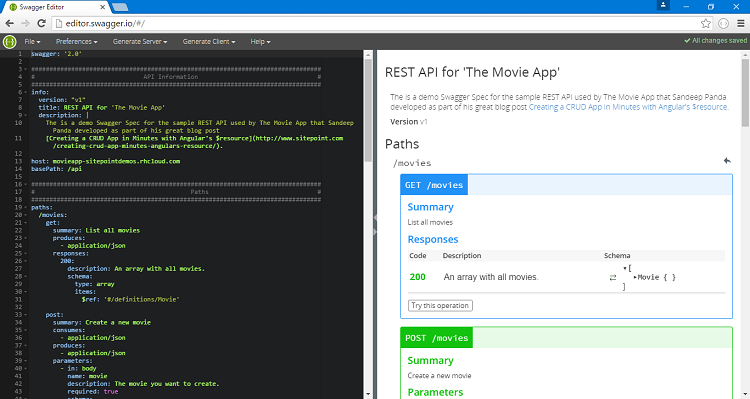


- Swagger editor 3.0 save file to location update#
- Swagger editor 3.0 save file to location code#
- Swagger editor 3.0 save file to location Offline#
Thanks goes to these wonderful people ( emoji key): Opening an issue beforehand to discuss isĮncouraged but not required. PRs are welcome! Please see our CONTRIBUTING.md guide.
Swagger editor 3.0 save file to location code#

Support converting any OpenAPI 3.0 or 2.0 (Swagger) schema to TypeScript types, no matter how complicated.format-this is just an example! You can use any property on a schema object to overwrite its generated type if desired.
Swagger editor 3.0 save file to location update#
But this will save you from having to also update all your types. Note that you will still have to do the parsing of your data yourself. This will generate updated_at?: Date instead. (Note: the swagger.json must be on the same host/port as the Swagger UI app, or you must enable CORS see the README. Internally it uses the official swagger-parser and my markup-document-builder.Import ) Also, from the Swagger Editor, you can export the JSON spec (not as YAML but as JSON) and the Swagger UI should be able to read that. Swagger2Markup supports the Swagger 1.2 and 2.0 specification. The Swagger source file can be located locally or remotely via HTTP. Swagger2Markup converts a Swagger JSON or YAML file into several AsciiDoc or GitHub Flavored Markdown documents which can be combined with hand-written documentation. NOTE: The Swagger Specification has been donated to to the Open API Initiative (OAI) and has been renamed to the OpenAPI Specification. The output of Swagger2Markup can be used as an alternative to swagger-ui and can be served as static content.
Swagger editor 3.0 save file to location Offline#
The result is intended to be an up-to-date, easy-to-read, on- and offline user guide, comparable to GitHub’s API documentation. The primary goal of this project is to simplify the generation of an up-to-date RESTful API documentation by combining documentation that’s been hand-written with auto-generated API documentation produced by Swagger. Swagger2markup - A Swagger to AsciiDoc or Markdown converter to simplify the generation of an up-to-date RESTful API documentation by combining documentation that’s been hand-written with auto-generated API documentation NET for JSON Schema handling and C#/TypeScript class/interface generation. To reduce the application complexity, the wireflow editor allows you to specify a particular path (or often called scenario). The NSwag project heavily uses NJsonSchema for. inheritance, enum and reference handling). The file parameter must have type: file: summary: Uploads a file. That is, your API server must consume multipart/form-data for this operation: The operation payload is defined using formData parameters (not body parameters). API Manager supports Open API 3.0 and Open. This way a lot of incompatibilites can be avoided and features which are not well described by the Swagger specification or JSON Schema are better supported (e.g. Swagger 2.0 supports file uploads sent with Content-Type: multipart/form-data. The Swagger Editor is a dependency-free collection of HTML, JavaScript, and CSS that dynamically generate. The project combines the functionality of Swashbuckle (Swagger generation) and AutoRest (client generation) in one toolchain. The NSwag project provides tools to generate Swagger specifications from existing ASP.NET Web API controllers and client code from these Swagger specifications. The Swagger specification uses JSON and JSON Schema to describe a RESTful web API. NET Core, Web API, ASP.NET Core, TypeScript (jQuery, AngularJS, Angular 2+, Aurelia, KnockoutJS, and more) and other platforms, written in C#. NSwag is a Swagger/OpenAPI 2.0 and 3.0 toolchain for. NSwag - The Swagger/OpenAPI toolchain for.


 0 kommentar(er)
0 kommentar(er)
